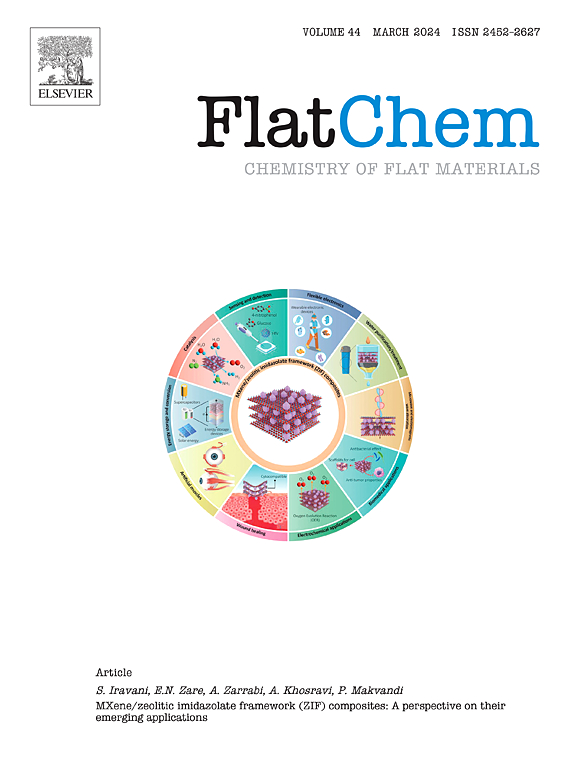从形态控制到光催化活性:磁化水创新和绿色合成二维层状BiOI及其在中心复合设计(CCD)光降解有机染料中的应用
IF 6.2
3区 材料科学
Q2 CHEMISTRY, PHYSICAL
引用次数: 0
摘要
本研究探索了用溶剂磁化装置(SMA)磁化普通水作为环保溶剂的创新用途,简称磁化水。然后将磁化后的水用作溶剂来合成氧化碘化铋(BiOI)光催化剂。此外,研究了合成的BiOI的形态和光催化活性,并与普通水制备的结构进行了比较。利用XRD、FESEM、BET、UV-Vis、PL、光电流响应、DRS和EIS等技术了解光活性纳米结构的特征和性质。通过优化施加于水中的磁场曝光时间,有效地控制了BiOI结构的形态,使二维纳米片形成三维花状纳米结构。在可见光照射下对BiOI的光催化性能进行了评估,结果表明,Bi- 15和光催化剂对罗丹明B (RhB)的降解率约为95%,Bi-1光催化剂对刚果红(CR)的降解率约为45分钟。使用Design Expert软件进行的统计分析突出了pH、照射时间和光催化剂用量对降解的显着影响。动力学研究遵循一阶动力学,根据准一阶模型对RhB和CR进行降解。最后,对光催化剂的稳定性进行了研究,经过5次循环后,光催化剂的性能没有明显下降。此外,使用磁化水可以通过提高反应效率和减少对昂贵的化学品和能源的需求来降低合成成本。本文章由计算机程序翻译,如有差异,请以英文原文为准。

From morphology control to photocatalytic activity: Magnetized water for the innovative and green synthesis of 2D layered BiOI and its application in the photodegradation of organic dyes using central composite design (CCD)
This study explores the innovative use of ordinary water as an eco-friendly solvent magnetized by a solvent magnetizing apparatus (SMA), which is referred to as magnetized water. This magnetized water is then used as a solvent to synthesize bismuth oxyiodide (BiOI) photocatalysts. Moreover, the morphologies and photocatalytic activity of the synthesized BiOI are investigated and compared with structures obtained using ordinary water. Techniques such as XRD, FESEM, BET, UV–Vis spectroscopy, PL, photocurrent response, DRS, and EIS were used to understand the characteristics and properties of the photoactive nanostructures. By optimizing the exposure time of the magnetic field applied to the water, the morphology of BiOI structures was effectively controlled, resulting in the formation of three-dimensional flower-like nanostructures from two-dimensional nanosheets. The photocatalytic performance of BiOI was evaluated under visible light irradiation, demonstrating enhanced performance with approximately 95 % degradation for Rhodamine B (RhB) by Bi−15 and Congo Red (CR) by Bi-1 pass photocatalysts in almost 45 min. Statistical analysis using Design Expert software highlighted the significant effect of pH, irradiation time, and photocatalyst dosage on the degradation. Kinetic studies followed first-order kinetics according to the pseudo-first-order model for both RhB and CR degradation. Finally, the stability of the photocatalysts was investigated, and no significant decrease in the performance of photocatalysts was observed after five cycles. Additionally, using magnetized water can lower synthesis costs by enhancing reaction efficiency and reducing the need for expensive chemicals and energy.
求助全文
通过发布文献求助,成功后即可免费获取论文全文。
去求助
来源期刊

FlatChem
Multiple-
CiteScore
8.40
自引率
6.50%
发文量
104
审稿时长
26 days
期刊介绍:
FlatChem - Chemistry of Flat Materials, a new voice in the community, publishes original and significant, cutting-edge research related to the chemistry of graphene and related 2D & layered materials. The overall aim of the journal is to combine the chemistry and applications of these materials, where the submission of communications, full papers, and concepts should contain chemistry in a materials context, which can be both experimental and/or theoretical. In addition to original research articles, FlatChem also offers reviews, minireviews, highlights and perspectives on the future of this research area with the scientific leaders in fields related to Flat Materials. Topics of interest include, but are not limited to, the following: -Design, synthesis, applications and investigation of graphene, graphene related materials and other 2D & layered materials (for example Silicene, Germanene, Phosphorene, MXenes, Boron nitride, Transition metal dichalcogenides) -Characterization of these materials using all forms of spectroscopy and microscopy techniques -Chemical modification or functionalization and dispersion of these materials, as well as interactions with other materials -Exploring the surface chemistry of these materials for applications in: Sensors or detectors in electrochemical/Lab on a Chip devices, Composite materials, Membranes, Environment technology, Catalysis for energy storage and conversion (for example fuel cells, supercapacitors, batteries, hydrogen storage), Biomedical technology (drug delivery, biosensing, bioimaging)
 求助内容:
求助内容: 应助结果提醒方式:
应助结果提醒方式:


